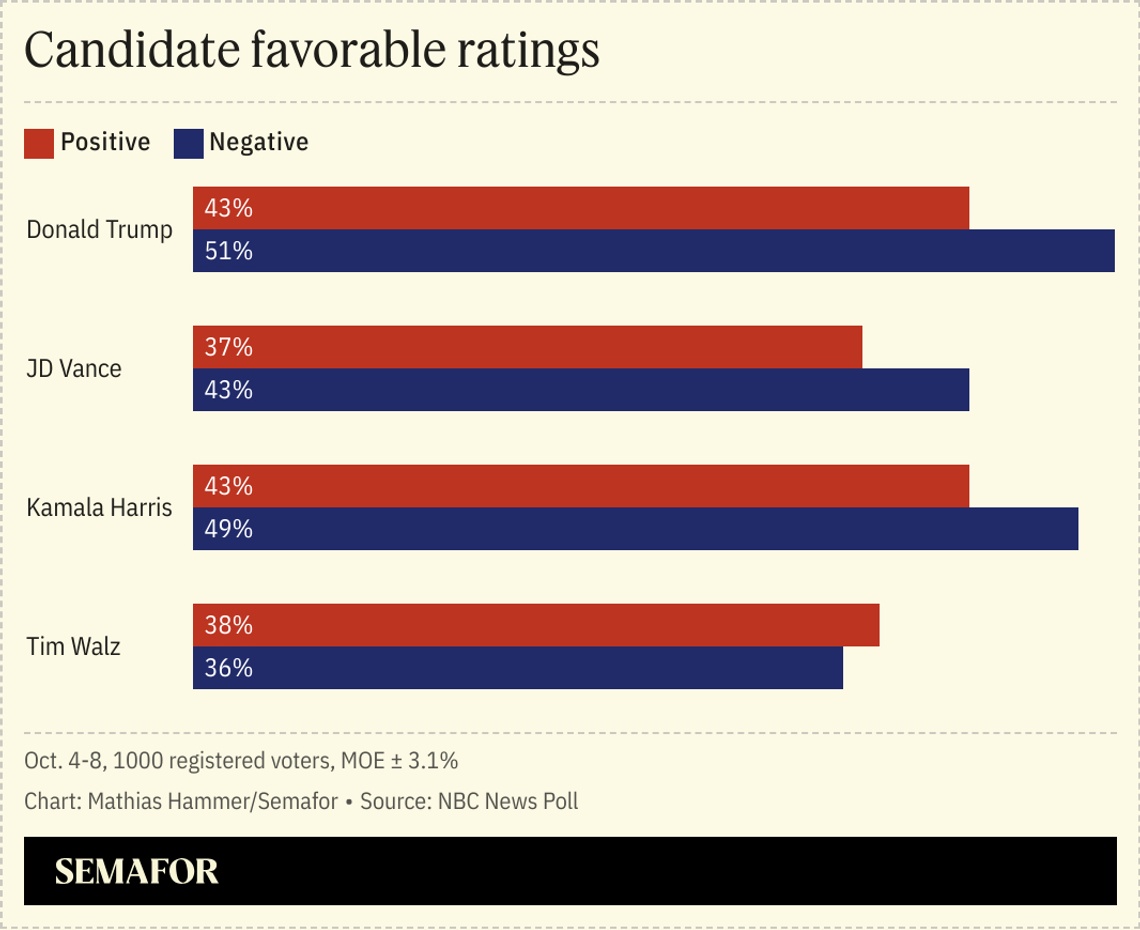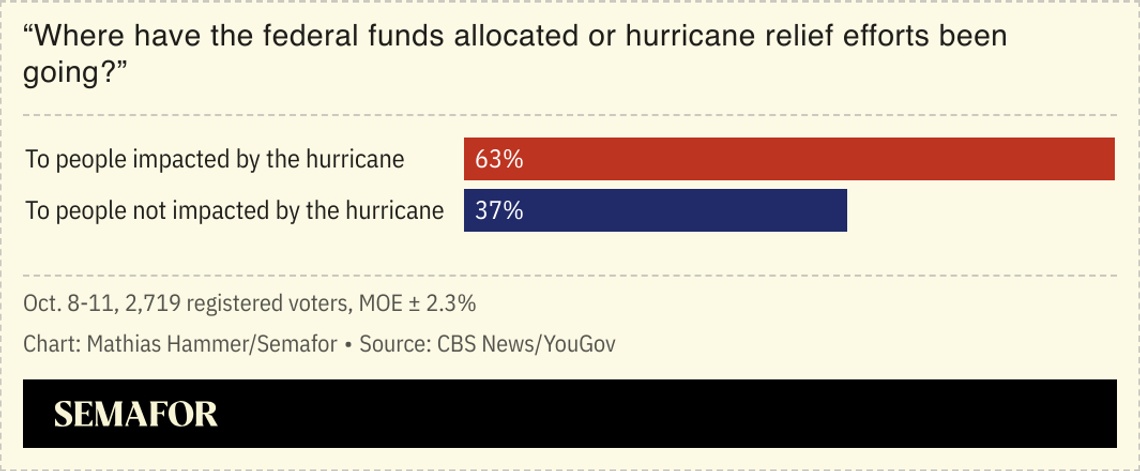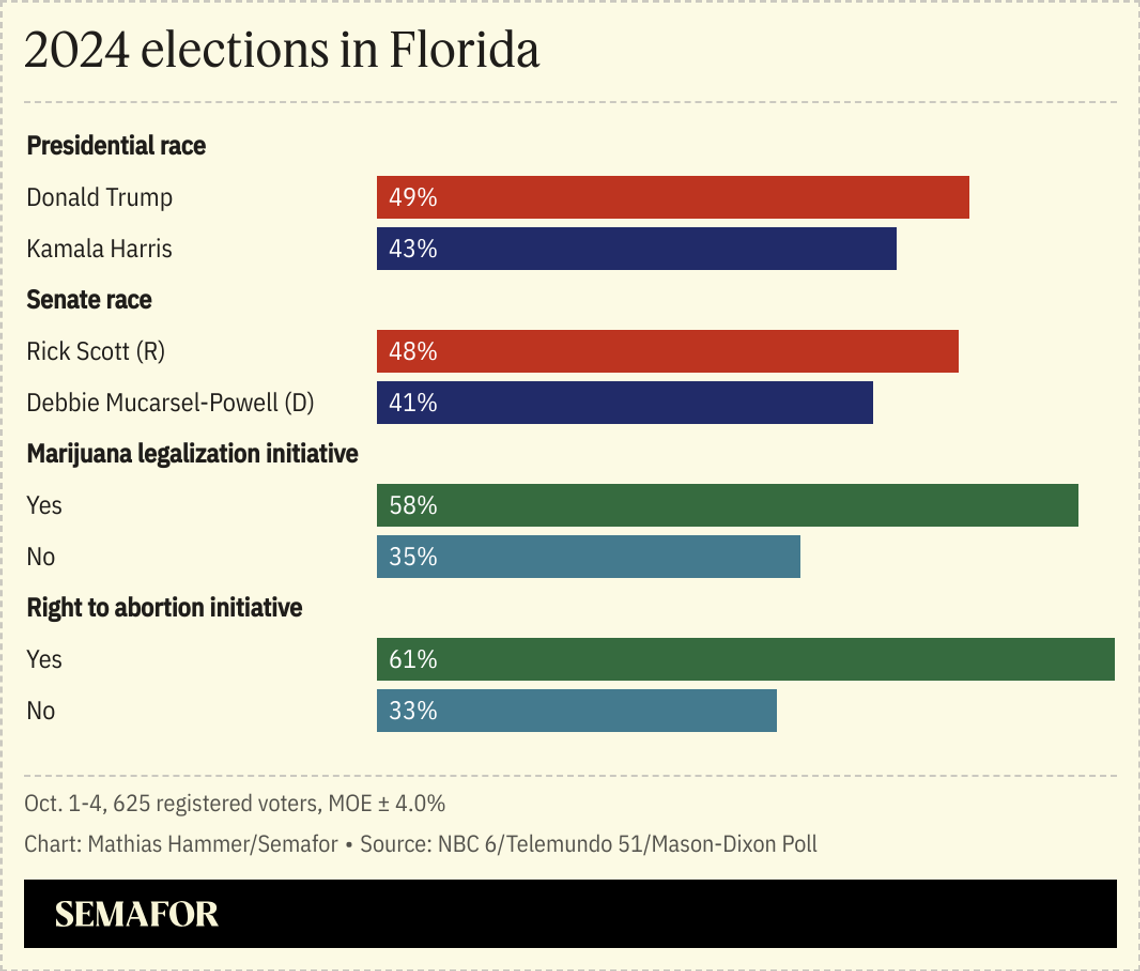 Polls The story of September was the Harris campaign and the Future Forward super PAC bombarding swing states with positive ads, and driving up her favorable ratings. This is one of several polls in the last 72 hours that find the vice president’s lead slipping, from a small one to a tie. Here, it’s in sync with changing views of the candidates, and a warmer view of Trump’s presidency, with 48% of voters saying they like “how he handled his job” as president. By an 18-point margin, they say they trust Trump more to handle “Israel’s military conflict against Hamas and Hezbollah,” a position he’s come into without specifying how he’d end the war. The Democratic ticket is still more personally popular and more seen as bringing “change,” but it’s viewed less competently than it was a month ago.  Republican voters are ready to believe the worst. Donald Trump’s repeated insistence that the Biden administration frittered away FEMA money to resettle migrants didn’t convince most voters that this was true. The Shelter and Services Program has a different revenue stream than FEMA’s disaster relief; the money appropriated to deal with hurricane damage hasn’t been expended. But 62% of Republicans say that relief funds have “mostly” gone to non-victims, and 81% say that the money has likely gone to “people in the country illegally” — and more than half of Trump voters say that the numbers of migrants crossing the border is increasing. Both beliefs are untrue.  Democrats have endorsed both of Florida’s high-profile ballot amendments, which will pass if they get 60% of the vote or more. Both measures are running ahead of their candidates, with no coattail effect. One reason: Their coalitions don’t quite match up. Just 7% of Democrats say they’re voting for Trump, and about as many oppose the abortion measure, but 21% oppose the marijuana legalization initiative. Latino voters break for Trump and Scott in the federal races, but narrow majorities of them support the abortion (54%) and marijuana (52%) measures. Both get support from a libertarian/liberal coalition that can’t be recreated in partisan races. Ads Kamala Harris/YouTube Kamala Harris/YouTube- Harris for President, “Enemy Within.” The Harris campaign and its PACs have been running ad after ad about the Republicans who support her and the Trump administration veterans who won’t support him. Deploying footage from Trump’s Coachella rally, when he talked about targeting “the enemy within,” the ad uses two former Trump homeland security advisors to warn that he might deploy military power against critics if he wins again. “Unchecked power, no guardrails,” says Kevin Carroll, as a camera zooms in on a smiling JD Vance.
- McCormick for Governor, “Common Sense.” Democrats lost to Jennifer McCormick in 2016, when she won the state’s independent education office as a Republican. The party then got rid of the office, and McCormick became a Democrat, arguing that her old party had gone too far to the right. She name-checks the whole Republican gubernatorial ticket here, including conservative lieutenant governor nominee Micah Beckwith, calling it too obsessed with the wrong issues. She’d “repeal the abortion ban” and “end book bans” to undo their work.
- NRCC and Iowans for Zach Nunn, “Chasity.” Two trends make it into this spot: A woman making the case for a male nominee, and footage of a facemask-wearing Democrat that’s meant to make him look radical. Chasity Meinders, a black suburbanite who sounds like the sort of voter Iowa Republicans are losing, says that inflation has hurt her family and Democratic congressional nominee Lanon Baccam is a “paid political activist” who can’t fix that. To show how out-of-touch he is: An undated photo of the candidate in an N-95.
ScoopedThis newsletter was very early to the story of Nebraska Republicans trying to change how their state awarded electoral votes. It was pretty early to the U.S. Senate campaign of Dan Osborn, a union organizer running as an independent and running competitively with Sen. Deb Fischer. But Kathy Gilsinan wrote the on-the-ground story I needed, about the local party dynamics that have put Omaha and its district in play for Democrats, both at the presidential and House level. Next  - 21 days until the 2024 presidential election
- 63 days until the Electoral College votes
David RecommendsHow would mass deportation actually work? When pressed, Donald Trump and JD Vance have answers, and usually challenge the skepticism of their media interviewers. “I think it’s interesting that people focus on, well, how do you deport 18 million people? Let’s start with 1 million,” Vance told ABC News this summer. Radley Balko, who has worked the crime and justice beat for his whole career, reports on the logistics of a potential mass deportation, from which agencies would be tasked to who would actually be working on the ground. He’s not a fan: “We’d have a deportation army working for a DHS or DOJ staffed with Trump loyalists who don’t believe in birthright citizenship, don’t believe that even naturalized citizens are ‘real’ citizens, and who, like Trump, believe immigration enforcement officers should be ‘unleashed’ from the constraints that come with respecting the rights of the people they detain.” |